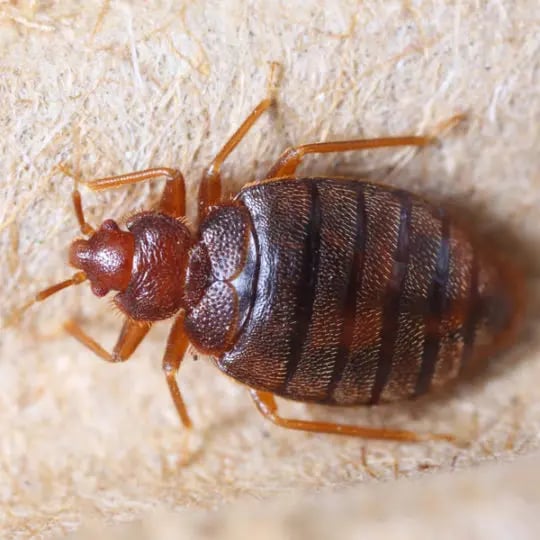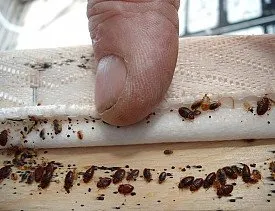Discovering the Scientific Research Behind Bed Pest Heat Treatments as a Lasting Insect Administration Strategy
In the world of insect monitoring, the quest for lasting and efficient solutions stays a continuous search. One such method that has obtained traction recently is using heat treatments to deal with bed pest problems. By taking advantage of the science behind thermal death points for these consistent parasites, warmth treatments supply an appealing option to typical chemical-based strategies. The complexities of exactly how warm efficiently gets rid of bed insects and the more comprehensive effects for lasting parasite management methods make this a topic worth checking out further.
Bed Insect Warm Treatment Refine

Thermal Death Factor for Bed Pests
Revealing bed pests to raised temperature levels past their thermal tolerance variety is important for accomplishing effective removal in warm treatment procedures. The thermal fatality point for bed bugs describes the temperature at which these pests can not endure. Research study suggests that bed bugs begin to perish when subjected to temperature levels above 113 ° F(45 ° C) for a continual period. As the temperature level boosts, so does the mortality rate of bed pests. At around 118 ° F(48 ° C ), bed insects begin to die rapidly, with a death rate of nearly 99% within mins of exposure. This shows the level of sensitivity of bed insects to heats and highlights the performance of warm therapies in getting rid of invasions. By getting to and keeping temperatures over the thermal death factor for bed insects, pest management specialists can guarantee comprehensive removal of bed bug populaces, consisting of hard-to-reach areas where chemical therapies may be much less effective. Comprehending the thermal fatality point for bed pests is essential for executing successful warmth treatment strategies and accomplishing lasting insect monitoring end results.
Advantages of Warm Treatments
Having actually developed the critical thermal death point for bed insects, it is essential to now explore the significant advantages that heat treatments offer in efficiently eliminating these durable insects. Heat treatments existing numerous vital advantages when contrasted to standard chemical techniques. Among the key advantages is that heat can penetrate deep right into splits and gaps where bed insects hide, ensuring that also the most hard-to-reach areas are warmed to lethal temperatures. This extensive approach not just kills real-time insects but also targets bed pest eggs, stopping future infestations.
Additionally, warmth therapies are ecologically pleasant and safe, making them a sustainable pest administration approach. Unlike chemical pesticides, heat treatments do not leave harmful residues that can present risks to human health and wellness or blog the setting. This facet is particularly crucial in delicate settings such as medical facilities, institutions, and residential locations where chemical use may not be preferable.
Additionally, warm therapies have a high success price in removing bed bug invasions in a solitary treatment, lowering the demand for numerous check outs and lessening interruption to passengers. This performance not just saves time and cash yet additionally supplies tranquility of mind to those managing bed bug problems.
Effectiveness of Heat Therapy

Research research studies have actually regularly shown the performance of heat treatments in accomplishing a high rate of bed bug mortality. Effectively conducted warm treatments can get to all the gaps and splits where bed pests may be harboring, making sure a comprehensive technique to elimination. Furthermore, heat treatments have the added benefit of killing bed pest eggs, which are often resistant to standard chemical therapies. In general, the efficiency of heat therapies in getting rid of bed pest problems makes them a lasting and trusted bug administration method.
Lasting Bug Administration Benefits
Implementing sustainable pest administration practices provides lasting benefits for both the atmosphere and public health and wellness. By using methods such as heat treatments for insect control, we can decrease the dependence on dangerous chemical pesticides that can have negative effects on environments and human health - DC exterminator. Lasting insect monitoring techniques aid in preserving biodiversity by targeting details insects without harming non-target microorganisms, thereby maintaining a balanced ecosystem
In addition, lasting bug management practices add to the total health and wellness and health of get redirected here the general public. By reducing exposure to harmful chemicals used in traditional insect control methods, warm therapies provide a more secure choice for bug administration in household, business, and public spaces. This reduction in chemical use additionally assists in protecting against pesticide residues from polluting water, air, and dirt, guarding ecological top quality.
Final Thought
To conclude, bed pest warmth treatments have actually been shown to be a efficient and lasting insect administration strategy. The thermal fatality point for bed bugs makes them susceptible to warmth treatments, which have various advantages over typical chemical treatments. The efficiency of warmth treatments in getting rid of bed pest infestations while lessening ecological effect highlights the possibility of this approach as a sustainable remedy for bug control.
The bed insect warm therapy process entails raising the temperature within infested locations to a level that efficiently gets rid of bed bugs and their eggs. By reaching and preserving temperatures above the thermal fatality point for bed pests, insect management professionals can make certain comprehensive removal of bed pest populations, including hard-to-reach locations where chemical treatments might be less efficient. One of the primary benefits is that heat can permeate deep right into crevices and splits where bed insects hide, making sure that even the most hard-to-reach areas are heated to deadly temperatures. Unlike chemical therapies that might leave behind immune populaces, warm treatments use a non-toxic and environmentally pleasant option that can pass through deep right into furniture, wall surfaces, and various other hard-to-reach locations where bed pests hide.
The thermal death point for bed bugs makes them at risk to heat treatments, which have numerous benefits over standard chemical treatments.